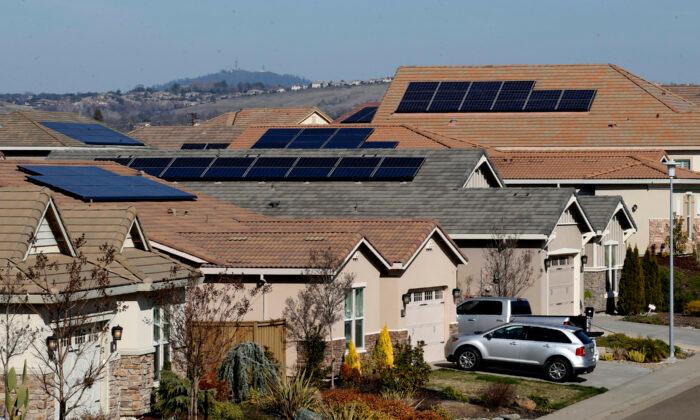California’s Public Utilities Commission unanimously approved a policy Dec. 15 that lessens credits for excess power for the state’s rooftop solar owners as well as alters rates in favor of those who purchase home energy storage systems.
With storage, solar users can use stored power at night or give it back to the grid.
“For the rooftop solar industry to remain sustainable, we must place greater value on exports during the truly fossil-heavy time of day,” Commissioner John Reynolds said during the meeting. “In short, we are making this change because of our commitment to addressing climate change.”
According to the commission, solar panels can produce 12,000 megawatts of power—nearly six times more than the state’s last nuclear plant. Without storage systems, fossil fuels take over to maintain the grid when the sun is down, raising non-solar customer rates.
Since 2020, new homes in California are required to have solar but without the requirement for storage.
The fight over solar changes has dragged on for nearly two years. The lessened rate return will only affect future solar owners who receive energy through Pacific Gas and Electric, Southern California Edison, and San Diego Gas and Electric. There is no change for current rooftop solar owners.
Affordable Clean Energy—a utility-backed coalition—estimates that $4 billion in costs are shifted onto non-solar customers from solar ones. During evening hours, solar customers still receive energy from the grid without producing any in exchange.
Since the rate change doesn’t apply to existing rooftop solar customers, the cost shift will continue to raise energy bills for non-solar users, the coalition argued.
“Numerous independent studies and testimony from diverse parties make clear the current solar subsidy program forces low-income families, renters, seniors and anyone who doesn’t have rooftop solar to bankroll wealthier Californians’ solar systems. Today’s vote ensures this indefensible cost-shift will continue indefinitely,” Kathy Fairbanks, a spokesperson for the coalition, said in a statement.
With the value of rooftop solar going down, solar companies say they fear fewer people will buy into the program. The policy change for future solar customers means they will receive net billing credits for their excess energy, which is substantially less than the former net metering system.
“The solar and storage industry remains concerned that the transition from net metering to the new net billing structure is too abrupt and threatens to slow the deployment of rooftop solar in California,” Sean Gallagher, vice president of state and regulatory affairs for the Solar Energy Industries Association, said in a statement.
A transitional period for the switch offers incentives for those who install panels and storage systems within five years. Residents of tribal communities, disadvantaged neighborhoods, and those with low income are eligible to get double credits with an installation. Even so, some solar advocates said the price will still be too expensive for those groups regardless.
According to Bernadette Del Chiaro, executive director of the California Solar & Storage Association, the average solar and storage system can cost around $26,000 after a 30 percent deduction from federal tax credits.
The proposed change will save residential solar customers an average of $100 monthly, or $136 for those with storage systems, according to consumer advocacy group the Public Advocates Office.
“Clean energy use during the day must be extended into the evening. Solar with batteries does exactly that. It’s the next step toward a clean energy future that will improve the air we breathe, the communities we live in, and our overall quality of life,” the office’s director Matt Baker said in a statement.
According to the utility commission, it would take no more than nine years to recoup costs for installing a solar and battery system with the new payment structure.





